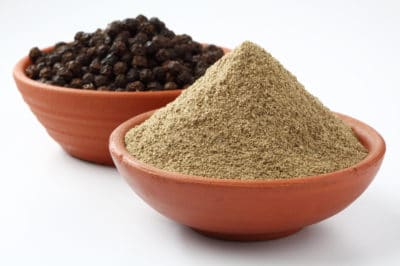Description
A peppercorn plant is a woody vine. It reaches heights of 13 feet and is usually supported with trellises. In nature, it’s often found winding its way up the trunk of a tree.
Commerical orchardists will grow Piper nigrum beneath shade-providing trees like coffee and mango. This polyculture helps to keep the vines strong and provides a secondary crop.
Once planted, a peppercorn plant will not fruit until its fifth or sixth year. A single stem can produce hundreds of peppercorns. They hang in clusters called spikes. Different peppers are created depending on when they spikes are harvested.
History
Black pepper has been a cash crop for over two thousand years. In ancient India, it was used as currency and titled ‘black gold.’ Peppercorns were found in the body of Ramses II, though historians are unsure how they got there. In Greece, pepper was only known to the rich and privileged.
The Romans sailed the same eastern trade routes that would dominate the black pepper trade for hundreds of years after. A fleet of ships would leave all at once making annual trips to China, Southeast Asia, and India using monsoon season to speed their journey. Pepper was among their chief imports. Pliny the Elder complains about the high prices of peppercorn in this writings.
13th-century writings from the explorer Marco Polo suggest that China’s black pepper business was far larger than Europes’ at the time. By the 15th century so much black pepper was coming into China it became a household commodity.
Black pepper came to the modern western world in the 16th century. The Malabar region of southern India was under British control and renown for its peppercorn plants. All of the black pepper entering Europe in the 16th century came from Malabar.
Today, 34% of the world’s peppercorn comes from Vietnam. They produce 163,000 tonnes annually. Other major producers of peppercorn include Brazil, Indonesia, and India.
Types of Pepper
Depending on when the peppercorn is harvested and how it is processed, there are three types of spice that result.
- Black Peppercorn
- Green Peppercorn
- White Peppercorn
Black peppercorn is the most commonly used. The peppercorns are harvested when they are still green and unripe. They are then briefly cooked and dried out in the sun. Enzymes turn the peppercorns black as they dry. The final result is a black, wrinkly peppercorn that when ground makes black pepper.
Green peppercorns are also the unripe fruit of the peppercorn plant. Instead of being dried or cooked, these are preserved in some way. Some green peppercorns are treated with sulfur dioxide or freeze-dried to prevent blackening. Others you can purchase canned.
White peppercorns are harvested when they are ripe and red on the plant. They are soaked in water for up to a week. This process dissolves the dark-colored skin on the outside of the seed. What is left is a smooth surfaced white peppercorn.
Sometimes orange and red peppercorns are available. Typically these are peppercorns soaked in a brine and colored by other spices. Pink peppercorns are not from Piper nigrum at all. These spicy kernels come from the Peruvian pepper tree and are related to cashews.
Medicine
Like so many spices, black pepper is not only used as a flavor but also a medicine throughout the ancient and modern world. The active and spicy compound within black pepper is called piperine. Piperine is currently being studied for its ability to increase the bodies absorption of certain nutrients including selenium, vitamin B12, curcumin, and beta-carotene.
Ancient societies used it as a folk medicine to treat gastric problems, constipation, insomnia, oral abscesses, and toothaches. Black pepper contains moderate amounts of vitamin K, manganese, and fiber along with phytochemicals. Extracts of piperine are available as medicinal supplements at health food and supplement stores.
Growing Peppercorn
Peppercorn plants (Piper nigrum) can be grown easily in USDA zones 10 and 11. These are tropical areas where it does not frost and stays fairly humid. Temperatures below 65°F (18°C) can cause the plant to stunt. Piper nigrum grows in containers that are brought inside or a greenhouse in cooler climates.
The vines will grow up to 12 feet in height and will require a trellis for support. These are large perennial plants that will spread out and dominate an area. Be sure you want them where you plant them.
